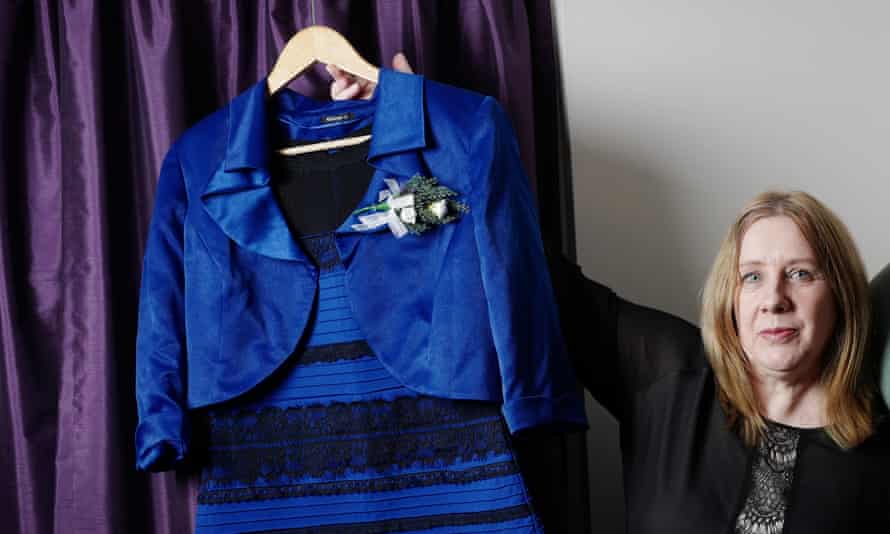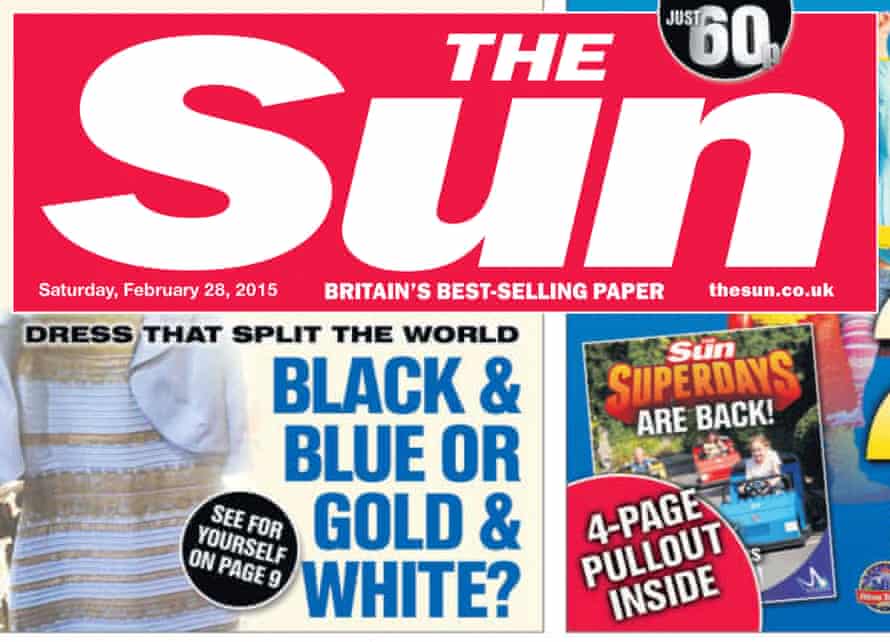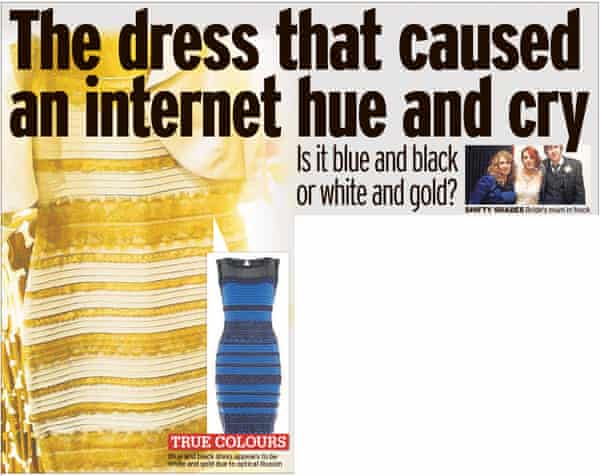The Dress Illusion All Over Again
It was #TheDress to end all dresses.
It began as someone attempting to observe a dress to wear to a wedding, and concluded in millions of tweets, countless articles and even a copyright dispute. This time last year, everyone on the internet, on Goggle box and in newspapers was arguing near the colour of a lace bodycon dress. From Tumblr, to Twitter, to BuzzFeed and across: #TheDress was everywhere.
But what is a viral meme if not a lesson for us all? A yr on, here's what we took from it all:
one. Sometimes information technology doesn't matter if it's 'not news'
Pre viral journalism, #TheDress would have stayed in its corner of Tumblr and weird Twitter every bit a curious oddity. Imagine going to an editor in a traditional newsroom pre-dress and trying to explain to them people on the cyberspace couldn't determine what color this dress was and you really thought information technology was something huge. You can besides imagine being laughed out of the room.
One thing's for sure, information technology never would take reached the stage it did without BuzzFeed'due south Cates Holderness, who runs the company'southward Tumblr, amidst other things. Speaking to Digiday, she explained how one of BuzzFeed's followers had sent the official account of the motion picture, asking: "Can you settle this argument for united states of america?" She said:
I got so confused, because it's clearly a blue dress. And then I'm looking at the comments, and people on Tumblr were freaking out and basically just yelling at each other. I called a couple people over and asked them, and half thought it was blue and half idea it was white. We started freaking out. There was a oversupply of people looking at this photograph and yelling at each other. One of the things we go by at BuzzFeed is, if it makes you lot feel something, y'all should mail it.
The mail, just a question asking "What colours are this dress?", took five minutes. The remainder is net history. From there, information technology became news, because no one could end talking about information technology. As tedious equally it may seem to some, a miracle such as the clothes is pretty hard to write off for "you call this news?!" reasons.
And spare a thought for BuzzFeed UK's Robin Edds, who discovered, likewise tardily, his mum was at the same wedding ceremony as #TheDress and could have nailed the scoop of the year.
ii. There's a lot more than to optical illusions than we ever idea possible
Why did some people see blackness and blue and others white and golden? Why did it alter for some people? Why were the 2 camps divide near neatly in two? WAS THIS SOME KIND OF Ill JOKE?
Ahem. The short answer is: the encephalon is weird and it does strange things. While everyone else was freaking out and arguing with one some other well-nigh the real color of the dress, scientists came frontward to try and explain this oddity. Marie Rogers wrote:
Some people'due south colour constancy is calibrated so that their brains tell them they are seeing gold and white, whereas some are led to believe they encounter black and blue. Of course, the colour constancy mechanism is always learning, and due to elevation-downwardly information (eg reading others' opinions) this calibration could change and lead to another experience. This may be the driving force behind people experiencing a shift from seeing white and gilt to blueish and black.
Researchers in America even went ahead and did a whole study on it:
Bevil Conway, a researcher at Wellesley College and MIT, asked 1,400 people, 300 of whom had never seen the pic earlier, to describe the clothes. Overall, 57% said it had blueish and black stripes, 30% saw white and gold stripes, and another 10% saw bluish and brown. About 10% could switch between either colour combination.
iii. People who create viral things by accident don't commonly get paid
In January 2016, Joe Veix wrote a piece on how "the weird, unfiltered net became a media goldmine", which in office looked at the economics of #TheDress.
Veix pointed out that while BuzzFeed was jubilant its traffic success with champagne, nobody else in the concatenation of production was getting paid.
Roman Originals, the dress's designers, likewise did well out of the furore. They only expected to sell near 200 of the dresses a week. But later millions of tweets, they concluded upwardly selling 3,000 a calendar week. Information technology sold out twice, and they even produced a 1-off white and gilded version, selling it at auction for £1,200 in aid of Children in Need.

Meanwhile, Cecilia Bleasdale, the woman who took the photo that started the meme and therefore owns the copyright, has attempted to chase up royalty payments. In December last yr, she told the Guardian the money collected so far hadn't paid their solicitor'due south fees.
The issue around copyright of the image has been a picayune muddled – many places, including BuzzFeed, embedded the Tumblr mail service which included the prototype. Simply that post has since been deleted, leaving a gaping whole in internet history.
4. Traditional media didn't know how to cover information technology

#TheDress highlighted how difficult it can be for traditional media outlets to cover viral phenomena. It had conspicuously acquired a lot of conversation online, just how on earth do yous tell the story in impress when the optical illusion disappears the minute the picture is printed?
Several papers made a stab at it, some even splashing altered pictures of the dress on the forepart page.

However, with impress deadlines not being favourable to the timing of a story that had cleaved in the United states, much of the coverage boiled downward to: "A couple of days ago loads of people were talking almost this dress on the internet because it was a fascinating optical illusion. To help yous understand this, we've printed a picture that won't alter colour, considering information technology is ink."

It was unclear what they were trying to tell their readers. If the reader had seen the apparel online, they had no need to be re-informed of it. And if they hadn't seen the dress online, then the description of it really yielded no insight.
5. People take continually looked for the next #TheDress
Viral content comes and goes in a social media flash. A recent piece looking at the 15-year-erstwhile meme "All Your Base Are Belong to Us" described a world where it took months and months for ane image to gain meme condition on the spider web.
Only now, viral content can be plant anywhere, and popularity is more of an explosion than a tedious burn. As Veix noted of #TheDress:
One of the biggest viral phenomena of the last decade started as a Facebook post with less than xx likes.
Have a gander on Twitter, and you lot'll see people trying to have a stab at information technology with other memes and optical illusions:
Nobody could have predicted that #TheDress would get so huge. It leads to people scrabbling around and publishing all sorts of things that might get the next large affair. Will it exist German students printing out memes and posting them on a door? Or trying to make up one's mind if red cabbage or reddish onions accept been thrown down a toilet? Or could it be Daniel, back at it over again with his white Vans? Who knows. Only we're willing to bet yous won't see it coming.
half dozen. Anybody will have something to say
As with annihilation the media gets a little flake obsessed over, there was no terminate to the think pieces. Yous had essays on the science, on the viral internet, on the fashion ... and and then in that location were the ones which went for a completely different angle, like Bevil Conway, who said she wasn't in team white or golden or team blue and black.
When I offset saw the clothes I thought information technology was orange and blueish, and a Photoshop analysis of the colours of the pixels of the dress shows this to be the instance. I am a visual artist, trained in painting. Painters mostly try to be mindful of what the visual system does to colours; I always endeavour to abstract colours from their surrounding context, where possible. This might explain why I see it differently than the two bulk camps. One way or some other, painters interested in capturing the colour of the natural earth must acquire how to do something rather unnatural: they have to learn to see the colour of light.
7. Tattoos of memes are a matter at present
Daniel Howland of Texas went 1 pace further than arguing with strangers on the internet. He gave the meme a permanent home on his leg.
Allow Instagram content?
This article includes content provided past Instagram . We inquire for your permission before anything is loaded, as they may be using cookies and other technologies. To view this content, click 'Allow and go on'.
Concluding year, he told BuzzFeed: "I pretty much got it because, I hateful, I proceed up with all the social memes and hysteria and whatever, and this is the just one that I really couldn't wrap my brain effectually. So I simply decided to exercise it."
And he's nevertheless at it this year – just the other day, he got a tattoo commemorating 2016'southward hottest meme and then far, Damn Daniel.
Allow Instagram content?
This article includes content provided by Instagram . Nosotros enquire for your permission before anything is loaded, as they may be using cookies and other technologies. To view this content, click 'Permit and continue'.
8. It could happen all over again when you least wait it
So beware.
Source: https://www.theguardian.com/media/2016/feb/26/thedress-one-year-on-8-things-we-learned-viral-phenomenon
0 Response to "The Dress Illusion All Over Again"
Post a Comment